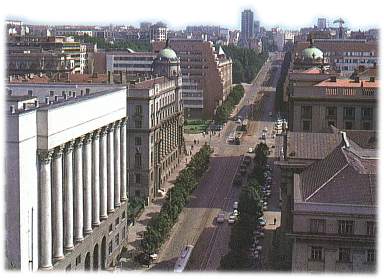
This became one of the town's main traffic arteries after the completion of
the railway station in 1884. It acquired its name in 1896.
 tefan Nemanja (b. Ribnica 1113/4 d. Mount Athos 1200), Serbian Grand Župan (chieftain)
and founder of the Nemanjić dynasty. He governed the district around Toplica, the lower
valley of the Ibar, Rasina, Reke and Dubočica. After the death of the Byzantine Emperor
Manuel Comnenus (1143-1180), Stefan attacked the Byzantines, who had joined forces with the
Hungarians. He continued the wage wars on his own and to expand his empire: he annexed Zeta,
Trebinje, Zahumlje and Metohija to Serbia. When Byzantium freed itself from the pressures of
the Crusades, it attacked Nemanja and compelled him to return all those lands he had
conquered across the Morava. He did, however, manage to retain Serbia's independence, and
in order to strengthen his power he relied on the church, on which he bestowed privileges,
gifts and large areas of land.
tefan Nemanja (b. Ribnica 1113/4 d. Mount Athos 1200), Serbian Grand Župan (chieftain)
and founder of the Nemanjić dynasty. He governed the district around Toplica, the lower
valley of the Ibar, Rasina, Reke and Dubočica. After the death of the Byzantine Emperor
Manuel Comnenus (1143-1180), Stefan attacked the Byzantines, who had joined forces with the
Hungarians. He continued the wage wars on his own and to expand his empire: he annexed Zeta,
Trebinje, Zahumlje and Metohija to Serbia. When Byzantium freed itself from the pressures of
the Crusades, it attacked Nemanja and compelled him to return all those lands he had
conquered across the Morava. He did, however, manage to retain Serbia's independence, and
in order to strengthen his power he relied on the church, on which he bestowed privileges,
gifts and large areas of land.



Albania Palace Building |
The Bajrakli Mosque |
Belgrade Palace Building |
Belgrade Railway Station |
Captain Miša's Building |
Cvijeta Zuzorić Art Pavilion |
Karađorđeva Street |
Knez Mihailova Street |
Princess Ljubica's Residence |
Millenary Monunemt on Gardoš Hill |
Price Miloš's Residence |
The National Theatre |
Nemanjina Street |
Nikola Pašic Square |
Republic Square |
Skadarlija |
Slavija Square |
Student Square |
The Trade Union Hall |
Terazije Square |
The '?' Cafe Restaurant |
Article about the architecture and building in Belgrade
| |


